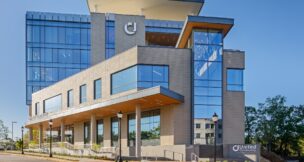Greenville and state leaders: tourism’s big role on economic growth
Krys Merryman //February 23, 2023//
Greenville and state leaders: tourism’s big role on economic growth
Krys Merryman //February 23, 2023//
 By 2040, Greenville economic organizations predict at least 220,000 more people will be living in Greenville County — that’ll be the equivalent of dropping Anderson County’s population into Greenville.
By 2040, Greenville economic organizations predict at least 220,000 more people will be living in Greenville County — that’ll be the equivalent of dropping Anderson County’s population into Greenville.
With that growth comes a lot of benefits but also a lot of challenges.
A panel consisting of the Greenville Chamber of Commerce President and CEO Carlos Phillips, Greenville Area Development Corp. President and CEO Mark Farris, S.C. Department of Commerce Deputy Secretary Ashely Teasdel, and VisitGreenvilleSC President and CEO Heath Dillard got together at the Greenville One Center on Wednesday to address Greenville’s tourism and the intersection of economic development.
“When people come here (to Greenville), they can’t help but love the place they have visited,” Dillard said.
The state saw $10.27 billion in capital investments last year — BMW’s Spartanburg expansion and Redwood Materials Ridgeville plant were major contributors — and will continue to see a shift in the automotive sector along with other manufacturing industries, Teasdel said. Federal investments have played a big role in foreign companies setting up shop in South Carolina and the Southeast, which is now known as the “battery belt,” she added.
“Any way we can continue to support these industries will be really important going forward,” Teasdel said.
But with new headquarters, plants and other facilities making their way to the state, site availability is limited and has also become a challenge, she added.
“We are seeing billion-dollar investments looking for thousands of people to fill their workforce,” she said. “And for a state that is relatively small, there are few places you can fit a mega site. We will have to have serious conversations when it come to new investments.”
The workforce is front and center, as it’s not just a South Carolina issue but a national one, said Teasdel.
As the unemployment rate is low in the state, there are still a lot of open jobs, she said. “Things have shifted since the pandemic.”
“Companies are considering the quality of life before making a big investment in the workforce they are tapping into,” Teasdel said. “Quality of life has risen as a top priority because workers are making the decisions — for their future family — and want live, work, play options. People want experiences, and that’s a huge factor in what makes Greenville more attractive.”
The Greenville market has a lot of great amenities and factors that keep it competitive, Dillard said.
“The people here really make the place and visitors feel that and feel welcomed when they come here,” he said. “We have created an environment that is clean, beautiful and safe. Tourism is often the front porch. Companies looking at capital investments feel it when they visit, and we believe our people in the Greenville community are our greatest asset.”
With the influx of companies and people moving to the city, Phillips said an additional 50,000 housing units over the next 20 years will be necessary as well as expanded infrastructure across the board — that means roadways, airports, broadband, etc.
“Growth is great, but with that growth does come opportunities over the coming years,” he added. “As people come to visit, they don’t want to just visit; they want to live here.”
But growth can also hijack a city’s brand, making it unrecognizable from what made it so lovable to begin with, Dillard said.
“We can’t prevent that from happening, but we can try to manage it, and that’s the challenge,” he added.
That challenge also includes a lack of affordable housing.
“Those communities that are on the margins and largely disproportionately affected by growth and affordable housing are often the people we want in the labor force,” said Dillard. “We need people to serve our guests and our visitors. As we may not be the organization who can specifically control infrastructure and affordable housing, we have to bring the perspective of the hospitality industry, and that’s taking a closer look at if our people can afford to live where they work.”
As the city manages its growth and challenges, said Dillard, they must do it collaboratively.
“Working with other agencies, taking a more holistic approach, and understanding it’s complex — using our tools and resources to work together to solve these challenges is crucial,” he added.
So, what are some solutions and goals to tackle these issues?
Farris said city organizations must do a better job at attracting the “right” people to address the major workforce issues.
For example, the emergence of remote workers, said Phillips. People can be based in California but have the option to move to places like Greenville and work from home.
“That means we aren’t filling jobs we have here,” he added. “This is a significant challenge to get those people to fill the workforce here.”
In terms of finding and keeping talent, said Phillips, employers play a significant role in that. He said they must be more innovative and flexible to retain talent but unfortunately not every employer is built to offer a flexible work environment, such as a work-from-home or hybrid option. However, this flexibility does contribute to a worker’s desire for work-life balance and is key to attracting talent.
Related article: This Greenville CEO on how to navigate post-COVID hiring
State and city organizations also have been adamant and active when it comes to recruiting college graduates to fill jobs.
“We continue to pump dollars into scholarships for technical colleges and incentive structures,” Teasdel said.
Farris said they can do a better job at keeping college graduates in the state to work, though.
“I don’t think we can stop the speeding up (of the growth),” said Farris. “Half of our projects are international, but they love it here because it reminds them of home, where they came from. When people come to Greenville, they establish a sense of place. And we have to take pride in that.”
a















